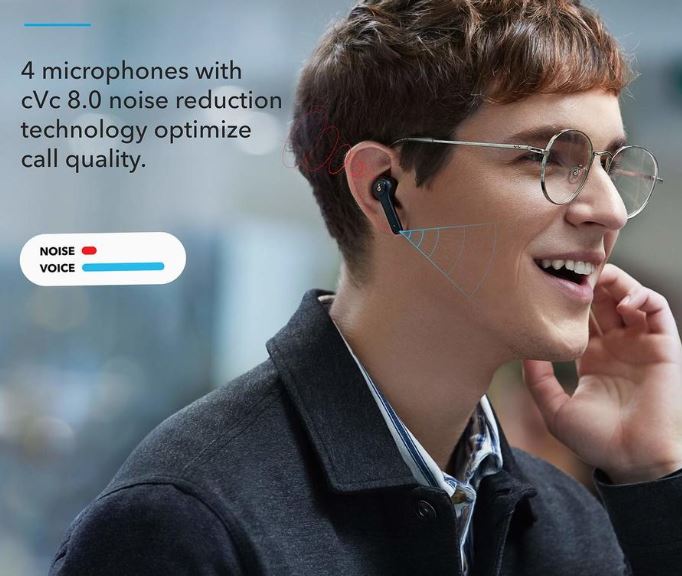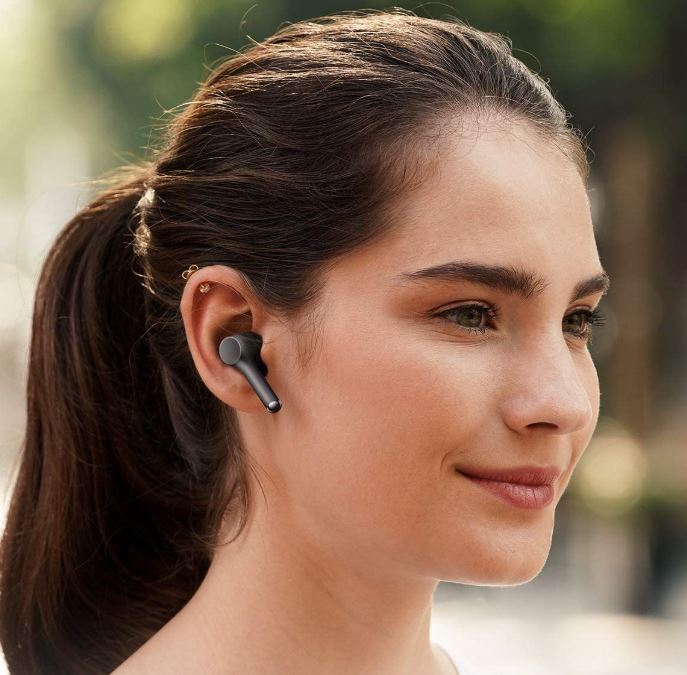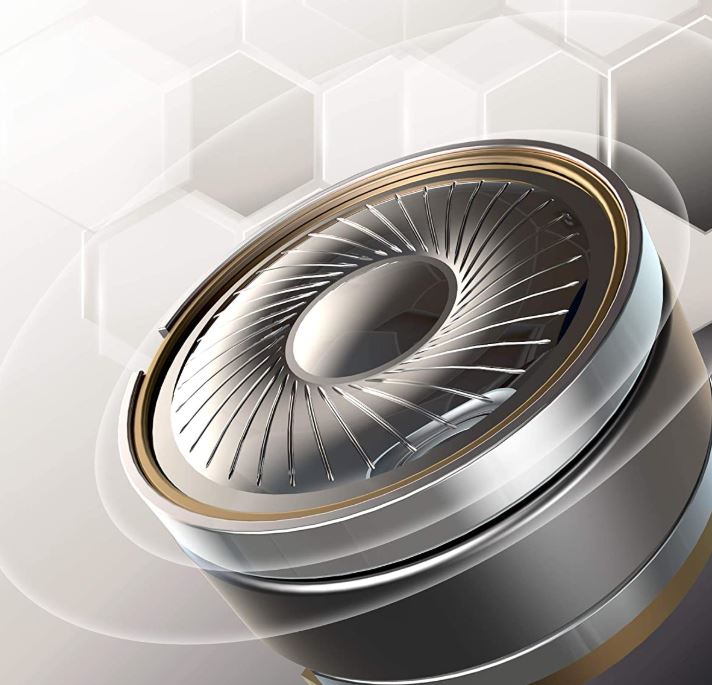When we review headphones and earbuds, we sometimes throw around a lot of terminology. For people who are big fans of technology, these terms will be familiar. But what if you’re not an expert? What if you just want to find a good set of earbuds? In that case, terms like “CVC” and “ANC” might just sound like Greek. That’s okay. We’re about to explain what both of these terms mean.
In a nutshell, both CVC and ANC are noise-canceling technologies. They’re designed to create a cleaner, clearer audio signal that’s easier to hear. But there are important differences between the two. Let’s take a closer look at each of them, so we can get a better understanding.
What is CVC?
CVC is short for “Clear Voice Capture”. It’s designed primarily for phone calls, but can also be used for podcasts and teleconferences. The purpose of CVC is to filter out background noise, so people can hear your voice more easily. If you’re on a phone call in a loud environment, it makes a huge difference in call quality. There have been several versions of CVC as the technology advanced. Currently, the latest version of CVC is CVC 8.0.

How Does CVC Work?
CVC works by using computer algorithms to detect and isolate the sound of your voice. Because it’s intelligent, it will work better the longer you’re on the phone. It also improves the clarity and quality of your voice, which also helps to improve clarity. In total, CVC 8.0 is capable of filtering out up to 30 decibels of ambient noise.
In other words, it’s not going to block loud noises like honking horns or screaming children. But it will significantly reduce the volume of those noises. So even when there’s a loud noise in the background, your voice will be the loudest thing on the call. Quieter noises like background traffic and wind will be eliminated almost entirely.
Many modern earbuds come with CVC technology. These earbuds will automatically start filtering out background noises from day one. Alternatively, you can install CVC apps on your smartphone to improve your earbuds’ function. Because CVC is a software solution, not a hardware solution, it can be used on a variety of devices. You can even install CVC apps on your laptop, PC, or Mac machine. This makes it useful not just for hands-free calling, but for teleconferencing and even for content creators.
In the past, we’ve reviewed several earbuds that utilize CVC technology. One of the best of these is the TRANYA B530 True Wireless Bluetooth Earbuds. Not only are they great for voice calls, they also sport a powerful charging case and excellent sound quality. They’re even water-resistant for workouts or foul weather.
What is ANC?
Active Noise Canceling (ANC) is a totally different animal from CVC. While CVC is designed to improve call quality for the other person, ANC is all about your own experience. ANC actively blocks out background noise while you’re on a call or listening to music. It’s often paired with passive noise canceling, especially in earbuds.
Passive noise canceling simply means that the earbuds provide a noise-blocking seal in your ear canal. When combined with passive noise canceling, ANC is even more effective. Passive noise canceling is less common in over-the-ear headphones, which can’t seal as tightly. As a result of this, as well as hardware requirements, ANC is more common in headphones than in earbuds.

So, what are the hardware requirements? First off, in order to filter background noise, the headphones need to know what that noise is. This requires a microphone inside the ear cup or the earbud. This will detect any sounds that have gotten through the passive seal. Secondly, special circuitry is required. This circuitry will create a noise fingerprint in order to determine what to block out. Then it will work with the speakers to create a canceling wave. As you can see, this will add to the size of the device. This makes ANC difficult – and expensive – to build into earbuds.
How Does ANC Work?
But how does the ANC actually cancel noise? The answer is the way sound works. Sound travels through the air as a wave. These waves oscillate, with peaks and troughs. An ANC system simply broadcasts reversed waves that cancel these other waves out. If this sounds a bit abstract, imagine that the peak of a wave is +1, and the trough is -1. The ANC system would create a -1 trough to coincide with the +1 peak, and vice versa for the trough. When combined, these waves add up to 0. In other words, the noise has been canceled out, and you hear nothing but your music. Pretty cool!
Active noise canceling is typically capable of reducing background noise by about 20 decibels. Because of this, it will effectively block out about 70 percent of background noise in most environments. Your actual results may vary depending on how loud the background noise is. That said, ANC is not perfect. There are a few downsides to this technology that we should mention.
ANC electronics need time to catch up to background noise. As a result, they’re not very effective at blocking sharp, sudden noises like car horns. They’re best suited for steady noise, such as airplane engines and train noise. Some users also feel that ANC headphones reduce the quality of music. This is subjective – and arguable – but it’s understandable.
You’re placing additional demands on your speakers, so it makes sense that the sound quality would suffer slightly. Most people won’t notice this, but serious audiophiles might. Finally, running the ANC technology puts additional demands on your battery. To help avoid this problem, most ANC headphones have an off switch. This way, you can turn the ANC function off when it’s not needed.
As we mentioned, ANC technology is primarily found in headphones. However, that doesn’t mean there are no earbuds that offer it. One solid choice is the Aukey Key Series T18NC. Not only do they cut down on background noise, but they’re quite comfortable to wear.

What’s the Difference?
There are two primary differences between CVC and ANC. As we hope we made clear, ANC is for you, CVC is for the other person on a phone call. In this sense, they’re fundamentally different technologies. CVC won’t help you hear your music any better, and ANC won’t improve your call quality. This is like comparing apples to oranges. Both technologies are great for their respective purpose, but they aren’t equivalent in any respect.
The other difference is that CVC is a software solution, ANC is a hardware solution. What does this mean? This means that CVC can be used on just about any device. Even if your headphones don’t offer it, you can find an app that does the job instead. ANC, meanwhile, requires extra microphones and circuitry. A device is either ANC-capable or it’s not. In other words, if you buy non-ANC headphones, you won’t be able to add the feature later. With CVC, on the other hand, you can decide to install it later if you decide that you need it.
Meet Ry, “TechGuru,” a 36-year-old technology enthusiast with a deep passion for tech innovations. With extensive experience, he specializes in gaming hardware and software, and has expertise in gadgets, custom PCs, and audio.
Besides writing about tech and reviewing new products, he enjoys traveling, hiking, and photography. Committed to keeping up with the latest industry trends, he aims to guide readers in making informed tech decisions.


THANK YOU, THANK YOU, THANK YOU!!!!
For this very simply and clear definition. I am definitely more able to make buying decisions now.
Really helpful; but I’m kind of puzzled how little good technical info there is about this on the net. For example, there’s nothing at all about CVC in Wikipedia. There seems to be only frothy marketing blurb available at Qualcomm, who you would have thought ought to have some proper info for tech nerds. (The difference between CVC 6.0 and 8.0 for example? Perhaps with some real detail, and numbers? There’s nothing.) Instead, we learn that CVC is “a suite of algorithms” that delivers “optimum voice quality”. Well, ya don’t say.
Hi,
Many thanks for the clear explanation above.
Can you please suggest a CVC app thats suitable for use with a laptop, and also a mobile (cell) phone?
I’m hoping to use it with a pair of SuperEQ S1 Hybrid Headphones.
Thank you.
Name of app for cvc for android ??
Salute you sir, you made it easy for me. I have completely understood the difference between cvc and anc. It’s cool to know that but can you please tell me which software can active cvc? ????
Finally a proper explanation for the layman. Great article. Made my day. Thank you very much!
Thanks so much. I go for CVC. I make a lot of calls.
Thank you so much. This article is perfect for it’s purpose and I now have an understanding of the difference between the two technologies. I am truly grateful.
I do hope that another article will be written about CVC technology exclusively. Now I understand what CVC does. I would like to know exactly how it does what it does. I would also like to know the difference between CVC 8.0 and its predecessors.
Again, thank you for a great article that was informative and well-written. I am in your debt.
Sincerely,
Doug Woodard
I have just purchased the a headset called infutureH1ANC headphones. While trying them out my side is crystal clear with or without the anc but when it comes to other people trying to hear me theres echoing or they can barly hear me. Would this be an instance where I download an extra cvc program to enhance the volume for callers on the other end?
Great one…i required for voice call not that much for music so if I purchase ANC nackband and install cvc software then it will work well for both purpose?